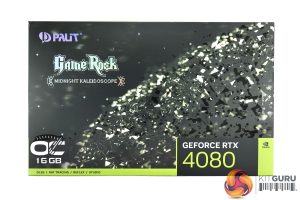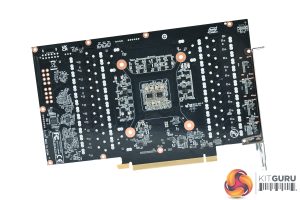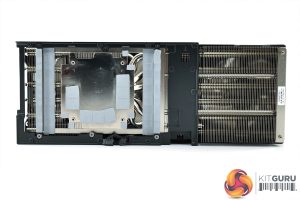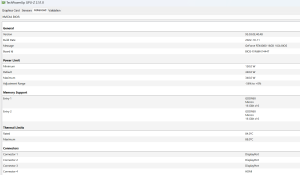
RTX 4080 has been on the market for about three weeks now, and today we're looking at another partner card. Palit's RTX 4080 GameRock OC carries over the blinged-out design from the RTX 4090 GameRock OC we reviewed in October, while also featuring an adjustable power limit that can reach up to 400W, alongside dual-BIOS support. It certainly has a lot going for it on paper, but is it worth buying?
Palit's RTX 4080 GameRock OC is certainly an eye-catching card, with its full-on RGB implementation that will probably end up a bit like marmite – you'll either love it or you'll hate it. Currently priced at £1299.95, it's only £30 more expensive than Nvidia's baseline MSRP, and considering the features on offer, it certainly looks tempting.
But with the arrival of AMD's RDNA 3-based GPUs now just two weeks away, is this RTX 4080 actually worth buying? Let's find out…
| RTX 4090 | RTX 4080 | RTX 3090 Ti | RTX 3090 | RTX 3080 Ti | RTX 3080 | |
| Process | TSMC N4 | TSMC N4 | Samsung 8N | Samsung 8N | Samsung 8N | Samsung 8N |
| SMs | 128 | 76 | 84 | 82 | 80 | 68 |
| CUDA Cores | 16384 | 9728 | 10752 | 10496 | 10240 | 8704 |
| Tensor Cores | 512 | 304 | 336 | 328 | 320 | 272 |
| RT Cores | 128 | 76 | 84 | 82 | 80 | 68 |
| Texture Units | 512 | 304 | 336 | 328 | 320 | 272 |
| ROPs | 176 | 112 | 112 | 112 | 112 | 96 |
| GPU Boost Clock | 2520 MHz | 2505 MHz | 1860 MHz | 1695 MHz | 1665 MHz | 1710 MHz |
| Memory Data Rate | 21 Gbps | 22.4 Gbps | 21 Gbps | 19.5 Gbps | 19 Gbps | 19 Gbps |
| L2 Cache | 73728 KB | 65536 KB | 6144 KB | 6144 KB | 6144 KB | 5120 KB |
| Total Video Memory | 24GB GDDR6X | 16GB GDDR6X | 24GB GDDR6X | 24GB GDDR6X | 12GB GDDR6X | 10GB GDDR6X |
| Memory Interface | 384-bit | 256-bit | 384-bit | 384-bit | 384-bit | 320-bit |
| Memory Bandwidth | 1008 GB/Sec | 716.8 GB/Sec | 1008 GB/Sec | 936 GB/Sec | 912 GB/Sec | 760 GB/Sec |
| TGP | 450W | 320W | 450W | 350W | 350W | 320W |
Above: Performance BIOS, left, Silent BIOS, right.
First, for a quick spec recap. RTX 4080 uses the AD103 die, and this is notably smaller than AD102, measuring 378.6mm2. Accordingly, transistor count is reduced from 76.3 billion, down to 45.9 billion. The fundamental building blocks are still the same of course, with the RTX 4080 offering a total of 84 Streaming Multiprocessors (SMs), each housing 128 CUDA Cores, for a total of 9728. We also find 84 RT cores, 336 Tensor cores, 336 Texture Units, and 112 ROPs.
TSMC's N4 node has Nvidia cranking up the clock speed significantly this generation, with the RTX 4080 sporting a 2505MHz rated boost clock. Palit has increased this further with a 35MHz factory overclock when using the Performance BIOS, though the Silent BIOS runs at reference speed.
The memory configuration is another area where AD103 has been cut-back significantly. The memory interface has been reduced to 256-bit, and even with 16GB GDDR6X running at 22.4Gbps, that cuts memory bandwidth down to 716.6GB/s. That said, there has been a substantial upgrade to the L2 cache with the Ada architecture, with the RTX 4080 now offering 65.5MB, compared to just 6MB for GA102.
Considering RTX 4080 is notably cut-down versus the RTX 4090, rated power draw is lower, with a 320W TGP. Palit has increased this to 340W for both the Performance BIOS and the Silent BIOS.
The Palit RTX 4080 GameRock OC ships in a dark box, with an eye-catching crystal-like pattern on the front. On the back, Palit highlights a few key features of the card and the cooler design.
Inside, we find a triple 8-pin power adapter, an ARGB cable used to synchronise the card's RGB lighting with your motherboard, and a height-adjustable GPU support bracket which screws into the side of the card to prevent GPU sag.
Looking at the card itself, the shroud and external design is identical to the RTX 4090 GameRock OC we reviewed in October.
That means we find a black plastic shroud, but with two large brushed metal plates to add more of a premium feel. It's impossible to miss the ‘crystal' plastic RGB diffusers too, which occupy almost the whole of the front of the card.
We also get a look at the three 90mm fans, using Palit's ‘gale hunter' design, with a new ‘winglet fantail' that Palit claims helps to increase airflow concentration.
As for overall dimensions, the card is exactly the same size as the 4090 model, measuring 329 x 137.5 x 71.5 mm. That means it's a 3.5 slot card, while it weighs in at just over 1.94KG, so you will want to use the included support bar.
Flipping the card over we get a look at the full-length metal backplate, with a number of cutouts to allow air to pass straight through the heatsink.
We can also see the dual-BIOS switch positioned just by the I/O bracket. The Performance BIOS is the default option, and that offers higher fan speed, clock speed and an adjustable power limit compared to the Silent BIOS, but we do test both modes later in this review.
We can also note the 12VHPWR power connector, with the RGB header positioned right next to this connector which lets you sync the lighting with your motherboard via the included cable. I do like this inclusion but the placement of the RGB header potentially causes a cable management headache, so I would have preferred to see this header on the end of the card.
Elsewhere, display outputs are as standard, with 3x DisplayPort 1.4 and 1x HDMI 2.1.
Palit is re-using the PCB design from the RTX 4090 GameRock OC, though with a slight tweak to the power delivery. Instead of a 16-phase VRM for the GPU, we find a 15-phase VRM, but still a 3-phase VRM for the memory. Palit is using 50A ONSemi NCP302150 MOSFETs across the board, with a UPI UP9512R controller for the GPU VRM and a UPI UP9529Q memory controller.
The cooler is really where we see the main difference between the 4080 and 4090. Instead of a vapour chamber, we find a traditional baseplate that sits on top of eight heatpipes. This baseplate contacts both the GPU and memory modules, with separate plates used to contact the VRM.
We can also note that Palit is not using any thermal pads on the underside of the backplate.
Driver Notes
- All AMD GPUs were benchmarked with the Adrenalin 22.10.3 driver.
- All Nvidia GPUs (except RTX 4080) were benchmarked with the 526.61 driver.
- RTX 4080 was benchmarked with the 527.72 driver supplied to press.
Benchmark results are only comparable where this exact configuration has been used.
Test System:
We test using a custom built system powered by MSI, based on Intel’s Alder Lake platform. You can read more about this system HERE and check out MSI on the CCL webstore HERE.
| CPU |
Intel Core i9-12900K
|
| Motherboard |
MSI MEG Z690 Unify
|
| Memory |
32GB (2x16GB) ADATA XPG Lancer DDR5 6000MHz
CL 40-40-40
|
| Graphics Card |
Varies
|
| SSD |
2TB MSI Spatium M480
|
| Chassis | MSI MPG Velox 100P Airflow |
| CPU Cooler |
MSI MEG CoreLiquid S360
|
| Power Supply |
Corsair 1200W HX Series Modular 80 Plus Platinum
|
| Operating System |
Windows 11 Pro 21H2
|
| Monitor |
MSI Optix MPG321UR-QD
|
| Resizable BAR |
Enabled for all supported GPUs
|
Comparison Graphics Cards List
- Sapphire RX 6950 XT Nitro+ 16GB
- AMD RX 6900 XT 16GB
- AMD RX 6800 XT 16GB
- Nvidia RTX 4090 Founders Edition 24GB
- Nvidia RTX 4080 Founders Edition 16GB
- Gigabyte RTX 4080 Gaming OC 16GB
- Inno3D RTX 4080 iChill X3 16GB
- Gigabyte RTX 3090 Ti Gaming 24GB
- Gigabyte RTX 3090 Eagle 24GB
- Nvidia RTX 3080 Ti Founders Edition 12GB
- Gigabyte RTX 3080 Eagle 10GB
All cards (except RTX 4080 AIB models) were tested at reference specifications.
Software and Games List
- 3DMark Fire Strike & Fire Strike Ultra (DX11 Synthetic)
- 3DMark Time Spy (DX12 Synthetic)
- 3DMark DirectX Raytracing feature test (DXR Synthetic)
- Assassin's Creed Valhalla (DX12)
- Cyberpunk 2077 (DX12)
- Days Gone (DX11)
- Dying Light 2 (DX12)
- Far Cry 6 (DX12)
- Forza Horizon 5 (DX12)
- God of War (DX11)
- Horizon Zero Dawn (DX12)
- Marvel's Spider-Man Remastered (DX12)
- Metro Exodus Enhanced Edition (DXR)
- Red Dead Redemption 2 (DX12)
- Resident Evil Village (DX12)
- Total War: Warhammer III (DX11)
We run each benchmark/game three times, and present mean averages in our graphs. We use FrameView to measure average frame rates as well as 1% low values across our three runs.
3DMark Time Spy is a DirectX 12 benchmark test for Windows 10 gaming PCs. Time Spy is one of the first DirectX 12 apps to be built the right way from the ground up to fully realize the performance gains that the new API offers. With its pure DirectX 12 engine, which supports new API features like asynchronous compute, explicit multi-adapter, and multi-threading, Time Spy is the ideal test for benchmarking the latest graphics cards. (UL).
3DMark Time Spy Extreme is an early indicator of GPU performance, with the GameRock OC out-scoring the Inno3D iChill X3 by about 140 points.
Here we test five games, all at 3840×2160 resolution using maximum image quality settings.
In terms of gaming performance, the GameRock OC did prove to be the fastest-running RTX 4080 we have tested so far. The margins are very slim however, as the GameRock was never more than 3% faster than the Founders Edition – so we're talking differences of just 3-4FPS at most.
Here we present the average clock speed for each graphics card while running Metro Exodus Enhanced Edition for 30 minutes. We use GPU-Z to record the GPU core frequency during gameplay. We calculate the average core frequency during the 30 minute run to present here.
The GameRock OC did clock the highest, explaining the small performance advantage it has in games. Over our thirty minute stress test, the card averaged 2819MHz using the Performance BIOS, so that's about 30MHz faster than the Inno3D iChill X3 and almost 100MHz faster than the Founders Edition.
For our temperature testing, we measure the peak GPU core temperature under load. A reading under load comes from running Metro Exodus Enhanced Edition for 30 minutes.
As for thermal performance, we can see competitive results from the GameRock OC. Using the Performance BIOS, the GPU peaked at 63.3C, while the Silent BIOS was only about 1C hotter. It may not be the outright coolest-running card, but it's hard to argue with thermal performance at sub-65C levels either way!
For our temperature testing, we measure the peak memory temperature under load. A reading under load comes from running Metro Exodus Enhanced Edition for 30 minutes.
Memory thermals aren't quite so competitive, with the Performance BIOS at 66C and the Silent BIOS at 68C. Those are still very good results, but are only small improvements over the Founders Edition – but once again, it's hard to argue when the temperatures are this low to begin with.
We take our noise measurements with the sound meter positioned 1 foot from the graphics card. I measured the noise floor to be 32 dBA, thus anything above this level can be attributed to the graphics cards. The power supply is passive for the entire power output range we tested all graphics cards in, while all CPU and system fans were disabled. A reading under load comes from running Metro Exodus Enhanced Edition for 30 minutes.
What makes the thermal performance so impressive is the low noise levels at which the GameRock OC operates. Using the Performance BIOS, the fans run at 1390rpm, while the Silent BIOS slowed the fans down to 1290rpm, making it the quietest RTX 4080 we have tested so far.
Following on from our stock thermal and acoustic testing, here we re-test the operating temperature of the GPU, but with noise levels normalised to 40dBa. This allows us to measure the efficiency of the overall cooling solution as varying noise levels as a result of more aggressive fan curves are no longer a factor.
We had to increase fan speed up to 1880rpm to hit 40dBa, and this saw noise-normalised GPU temperatures drop to 57.7C, putting it within 1C of the Gigabyte Gaming OC, so it's certainly an efficient cooler. The memory thermals are still slightly warmer, but at 60C it's still a good result, even if the Gaming OC and iChill X3 are a bit cooler.
We use Nvidia PCAT to measure power draw of the graphics card only, with readings from both the PCIe slot and the PCIe power cables combined into a single figure. We use Resident Evil Village (4K) for this testing.
Using the Performance BIOS, with its 340W TGP, results in power draw of the GameRock OC hitting 325W. This makes it the most power-hungry RTX 4080 I've tested, but it's still a bit below the rated TGP, and still draws less power than the RTX 3080.
For our manual overclocking tests, we used MSI Afterburner. Our best results are as below.
Above: Performance BIOS, left, Silent BIOS, right.
For overclocking, it's important to note that while the Performance BIOS power limit can be increased up to 400W, if you're using the Silent BIOS the power limit is locked at 100%, so it can't be adjusted above 340W.
Using the Performance BIOS then, we were able to add 110MHz to the GPU, though the memory didn't overclock that well, as anything above 1200MHz resulted in performance degradation.
The GPU frequency increased to an average of 2994MHz during our thirty minute stress test, a real-world increase of about 170MHz.
As for what difference this overclock actually makes, we saw improvement of around 6% in the three titles we re-tested, so it's not massive overall but is better than nothing.
Power draw did also rise by about 10W as a result of this overclock, which is barely a 3% increase.
As the fourth RTX 4080 card that we have reviewed, Palit's RTX 4080 GameRock OC is my pick of the bunch so far.
This starts with the overall design, which is broadly identical to the RTX 4090 model we reviewed in October. I appreciate that the bling-tastic approach with the ‘crystal' RGB diffusers won't be for everyone, but I personally think it looks fantastic and it's a real point of difference versus some other, more subdued-looking models.
Palit has also carried over its dual-BIOS implementation, with a choice of Performance or Silent modes, the latter offering the lowest noise levels of any RTX 4080 we have tested to-date. The Performance BIOS also runs the fastest of any 4080 we've reviewed, averaging over 2800MHz across our thirty-minute stress test.
Cooling performance is another strong point, and while it may not be the outright best cooler when noise-normalised, it does come very close. Temperatures below 65C are fantastic either way, so we can really have no major complaints about the GameRock OC. Yes, it is very large – and perhaps unnecessarily so considering the power requirements, but the same can be said for pretty much any RTX 4080.
So while I really do like what Palit has done here, ultimately this is still an RTX 4080 GPU – a product which really doesn't offer good value at all, so it's hard to be too enthusiastic here. That's especially the case with RDNA 3 set to launch in just a couple of weeks, so my advice to anyone looking to buy a high-end GPU is to wait and see what happens as we head into 2023.
If you are interested in the GameRock OC, we found it on sale for £1299.95 from Overclockers UK HERE.
Pros
- Excellent Dual-BIOS implementation
- Fastest RTX 4080 yet (though the margins are slim).
- Quietest RTX 4080 we've tested.
- RGB lighting is unique and rather eye-catching.
Cons
- RTX 4080 is poor value overall.
- ARGB header is awkwardly placed.
- RGB and overall design won't be for everyone.
KitGuru says: Palit has made a very good card with the GameRock OC – it's just a shame the RTX 4080 is too expensive for the performance on offer.
 KitGuru KitGuru.net – Tech News | Hardware News | Hardware Reviews | IOS | Mobile | Gaming | Graphics Cards
KitGuru KitGuru.net – Tech News | Hardware News | Hardware Reviews | IOS | Mobile | Gaming | Graphics Cards
















































